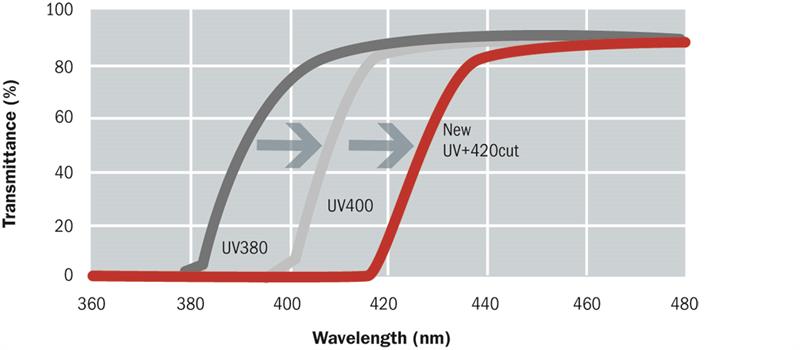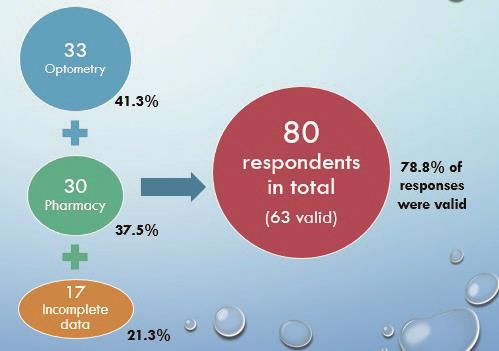BLU+V is a new ophthalmic lens material setting a new standard in ultraviolet light blocking. BLU+V completely blocks UV and blue light to 415nm with the secondary benefit of reducing blue violet light through to 450nm.
Why is it important?
BLU+V offers 100% blocking of light of wavelengths up to 415nm. This compares to CR39, for example, with a cut-off some 50nm further down the spectrum. With most mid and high index lens materials failing to achieve a complete block at 400nm, BLU+V offers unrivalled protection between 380 and 420nm wavelengths. As can be seen from the transmittance curve in figure 1, a further bonus with BLU+V is that it also blocks more than 25% of blue light at 435nm.
As the ultraviolet block is embedded within the lens material, your patient can enjoy a standard emerald reflex MAR coating or our patented smar.t multicoated anti-reflection coating with hydrophobic and oleophobic properties that are comparable with many of the best branded MAR coated lenses on the market today.
The lens material has a light grey colouration with a light transmission factor (LTF) of 93% and is normally supplied in conjunction with a hard multiple anti-reflection (HMAR) coating. A new lens material is rare and therefore we believe it deserves to be manufactured in the latest digital lens designs only.

Figure 1: Transmittance curve of BLU+V (in red)
Who may benefit from BLU+V?
Though authorities do not always agree, the visible light spectrum is usually taken to range from 380nm at the blue end through to 700nm at the red end. Ultraviolet light is found in the invisible range of the spectrum of shorter wavelengths than 380nm and is known to cause damage to living tissues depending upon its wavelength and level of exposure. Blue light generally is defined as visible light ranging from 380 to 500nm and is sometimes further broken down into blue-violet light or short wavelength visible (roughly 380 to 450nm) and blue-turquoise light (roughly 450 to 500nm) – see figure 2.

Figure 2: Wavelength classification of the light spectrum
Authorities generally do agree that 440nm wavelength blue light (high photon energy blue light) is potentially cytotoxic and has the potential to cause damage at, for example, the exposed macula. Protection of the macula is usually afforded by the human crystalline lens which absorbs increasingly the shorter visible spectrum as it yellows with age. Pseudophakes or younger patients, however, may not have such protection.
Other recent research has shown how continued exposure to such shorter wavelength blue has a cumulative impact and prolonged exposure to the output from, for example, some LED sources and so is best avoided.
Longer wavelength blue light, peaking at about 470nm, appears to be beneficial in stimulating light receptive retinal ganglion cells which are instrumental in regulating the body’s daily metabolic clock or circadian rhythm. Blocking light of this wavelength, or indeed allowing extended or continual exposure has an adverse impact on daily cycles, sleep patterns and health.
BLU+V is sold as lenses which we believe would potentially bring benefits to all particularly the young in reducing ultraviolet light exposure between 380-420nm.
Sports wear
Outdoor pursuits and extreme sports enthusiasts could well benefit from this new lens material’s protection for high altitude sports. The 1.5 BLU+V lens material can be additionally tinted to 15% LTF and could even have a mirror coating applied if you are planning an arctic expedition.
Night-time use
BLU+V can be worn day and night. The latter option may bring benefits to those who, when driving at night, really struggle with powerful halogen head lights. For many years we have maintained the best tint for night driving is no tint and suggested an anti-reflection coating as the only viable option. However, with so many patients suffering from discomfort maybe it is time to re-examine our normal dispensing rhetoric. The inclusion of a light filter, particularly one with blue-ultraviolet blocking properties, could help these spectacle wearers.
Future potential
As already mentioned because BLU+V is effective in blocking shorter wavelengths, there is a benefit to patients looking to reduce light impact from PCs, tablets and other digital LED devices at certain times of the day. This digital protection may be short-lived as device manufacturers continue to introduce software limiting short wavelength output from screens synchronised to the user’s daily cycle. We have already seen ‘Nightshift’ from Apple reduce blue light transmission with a subtle change of screen colour and they are not alone among manufacturers looking to add additional short wavelength visible light protection to their devices.
But we believe the UV absorption story will roll on for many more years. One area to watch is the increased use of UV and short wavelength light in industrial cleaning and sterilisation, and in quality inspection.
Another (pardon the pun) growth area is the use of selective short wavelength output LED light sources in indoor farms – with the largest farms in excess of 20,000 square feet. A recent study of indoor lettuce production reported a 100% yield increase with the introduction of latest generation of LED lighting. Advances in LED technology are helping to create an environment where vegetables can be produced at scale, with higher yields and shorter grow cycles, no matter what climate.
As cited on farmingfutures.org.uk, ‘Farming in a controlled environment, whether a greenhouse or warehouse, has long allowed growers to manipulate lighting, temperature and water to boost yields. What LED lighting brings to the equation is a cooler and more energy-efficient way to optimise conditions than the high-pressure sodium lamps traditionally found in greenhouses.’ Depending on the output, cumulative exposure to these LED sources needs to be considered by those concerned with eye health.
Dispensing notes
BLU+V is available in single vision, office and progressive digital lens design options across three indices; 1.5, 1.6 and 1.67. Table 1 summarises some key properties of BLU+V.
In terms of dispensing the digital lens types being supplied in BLU+V , the only change to dispensing practice would be to fully appreciate some of the underlying, life or work issues that may indicate BLU+V lens material could benefit.
Table 1: key points about BLU+V
- Reflects UV and potentially harmful blue light
- Transmits potentially beneficial longer wavelength blue (blue-turquoise) light
- No difference to colour perception
- May reduce digital eye strain when using electronic devices
- A unique filter built into the material of the lens meaning smar.t coating can be added or not – your
- choice
- Available in 1.50, 1.60 and 1.67 index
Paul Walden is technical and sales director for Lenstec Optical Laboratories
Further information from lenstec.co.uk
